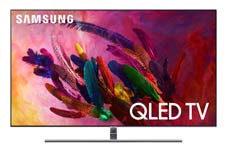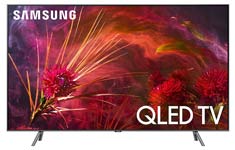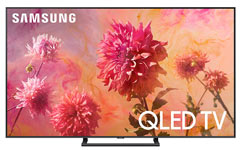Samsung Q6 Vs. Q7, Q8, Q9 QLED 4K TVs | 2018 (Differences, Reviews & Comparison)
September 22, 2019 by SmartReview
Filed under HDTV

![]()

Samsung QLED 4K (Quantum Dot) TV Lineup 2018
Also see the latest new 2021 models: Q60A, Q70A, Q80A & QN90A QLED 2021 TVs.
(Best Rated UHD TVs – Comparison, Differences & Reviews)
| Samsung Q6F 4K QLED Series (Flat LED TV) | Samsung Q7F 4K QLED Series (Flat LED TV) | Samsung Q8F 4K QLED Series (Flat LED TV) | Samsung Q9F 4K QLED Series (Flat LED TV) | ||||
|
|
|
| ||||
| 2160p 4K Ultra HD TV Q6 Series UHD LED Dimming 40 watt sound system Native 120Hz Motion Rate 240 4 HDMI (2.0) 802.11ac Wi-Fi Smart TV One Remote Quad Core Processor + Bluetooth® Support 4K Upscaling 2018 Model HEVC (H.265) codec Q Color Q HDR Q Engine Q Contrast Plus – – – + QLED Quantum Dot 1000 nits brightness Edge Lit Backlight | 2160p 4K Ultra HD TV Q7 Series Supreme UHD Dimming 40 watt sound system Native 120Hz Motion Rate 240 4 HDMI (2.0a) 802.11ac Wi-Fi Smart TV One Remote Quad Core Processor + Bluetooth® Support 4K Upscaling 2018 Model HEVC (H.265) codec Q Color Q HDR Elite Q Engine Q Contrast Plus Ultra Black Elite + QLED Quantum Dot 1500 nits brightness Edge Lit Backlight | 2160p 4K Ultra HD TV Q8 Series Full Array Dimming 60 watt sound system Native 120Hz Motion Rate 240 4 HDMI (2.0a) 802.11ac Wi-Fi Smart TV One Remote Quad Core Processor + Bluetooth® Support 4K Upscaling 2018 Model HEVC (H.265) codec Q Color Q HDR Elite Q Engine Q Contrast Elite Ultra Black Elite + QLED Quantum Dot 1500 nits brightness Full Array Backlight | 2160p 4K Ultra HD TV Q9 Series Full Array Dimming 60 watt sound system Native 120Hz Motion Rate 240 4 HDMI (2.0a) 802.11ac Wi-Fi Smart TV One Remote Quad Core Processor + Bluetooth® Support 4K Upscaling 2018 Model HEVC (H.265) codec Q Color Q HDR EliteMax Q Engine Q Contrast EliteMax Ultra Black Elite + QLED Quantum Dot 1500 nits brightness Full Array Backlight | ||||
| Models: QN55Q6F, QN65Q6F, QN75Q6F | Models: QN55Q7F, QN65Q7F, QN75Q7F | Models: QN55Q8F, QN65Q8F, QN75Q8F | Models: QN65Q9F, QN75Q9F | ||||
| | |||||||
Related Article: Samsung (Q80B Vs. QN90B) NEO QLED TV Comparison & Differences 2022
Related Article: Samsung (Q80A Vs. Q80B) QLED TV Comparison & Differences 2021-2022
Latest 2021 Models: Samsung (Q60A Vs. Q70A, Q80A, QN90A) QLED 2021 TV Comparison & Differences
Latest 2020 Models: Samsung Q60T Vs. Q70T Vs. Q80T Vs. Q90T QLED 4K TVs | Differences
Related Article: Samsung Q6FN Series QLED Quantum Dot TVs | Review
Related Article: Samsung Q7FN Series QLED Quantum Dot TVs | Review
Related Article: Samsung Q8FN Series QLED (Full Array) Quantum Dot TVs | Review
Related Article: Samsung Q9FN Series QLED (Full Array) Quantum Dot TVs | Review
Samsung QLED Vs. OLED: Samsung QLED TVs are catching up with OLED TVs in picture quality. Samsung QLED TVs are brighter than OLED and give a superior picture for HDR enabled programming. OLED still is superior in black levels, but the 2018 models have greatly improved black levels. In bright rooms, or rooms with lights on, the Samsung QLED is better. OLED still has an edge in response time and viewing angles, but Samsung’s high end QLED TVs are closing the gap.
| Samsung 4K TV Glossary of Terms |
| 4K Ultra HD (UHD) = 4K is the new standard in TVs. It has 8 megapixels of resolution, which is 4X the Resolution of Full HD 1080p TVs currently on the market. This allows you to sit closer to the TVs as the pixels are smaller, and will give you a more immersive movie theater type of experience. 4K TVs also give you richer and more natural colors (especially Samsung’s newest QLED Quantum Dot TVs). High Dynamic Range (HDR) = Samsung is going all in with HDR, which gives you brighter picture with colors that pop, and better picture when there is a lot of bright and dark areas on the picture. All 2018 4K models on this page are equipped able to take advantage of 4K HDR which will be available on 4K bluray discs and other sources. All provide the HDR 10 format support, which is one of the standards in the industry. QLED (Quantum Dots) = New for 2018, Samsung introduces its QLED Line (Q6FN Q7FN, Q8FN, and Q9FN). QLED is an advanced form of quantum dots). This technology will give a brighter picture with a much wider range of colors when compared to normal TVs. It also will provide deeper blacks. This is reserved for Samsung Top of line LED TVs. Q8 and Q9 Full Array Local Dimming = Only the Q8 and the Q9 models have full array led backlights and local dimming. This backlight system is superior to edge lit TVs, with more uniform picture and a higher number of local dimming zones for best picture, especially when using HDR. Nits Brightness = Nits is a measurement of brightness. The new QLED TVs are capable of 1,000 nits ( Q6 model), and 1,500 nits (Q7, Q8, Q9 Series). The higher the Nits, the more realistic the picture quality when utilizing HDR technology. This brightness in the QLED TVs far exceeds the brightness of older technology screens. Ultra Black Elite = This is a feature that reduces reflections when you are watching your TV with lights on. Most people watch their TVs with the lights on. Reflected light from windows can also be reduced with this feature. The Ultra Black Technology is only available in the Q7, Q8, and Q9 models. HEVC (H.265) codec = HEVC (H.265) is a new compression codec that is used to compress video. This new codec compresses twice as much data as previous codecs, so that 4K Ultra HD video can be sent over cable and the internet. HEVC (H.265) will allow 4K/60p playback for viewing 4K sports in the future. 4K/60p will also be available on future 4K camcorders. All of Samsung’s 2018 line of 4K TVs have HEVC installed. Netflix 4K Content is currently streamed using this HEVC decoder. What native 4K Content is Available Today? = Currently, Youtube, Amazon and Netflix are streaming 4K content to consumers. ESPN, Comcast Xfinity, and others have announced that they too will have 4K content. UHD LED Edge/Local Dimming = This combines the economy of an Edge Lit TV, with the advantages of local dimming. The picture quality, black levels, and contrast can be greatly enhanced with Local Dimming versus one that is only Edge Lit. This type of system can also eliminate or reduce halo effects, clouding, and light bleeding. Samsung calls their dimming technology Micro Dimming, while LG uses the term LED Plus. Full Array Local Dimming LED TV = An LED TV that is illuminated from the rear by an array of LED lights. These lights can be dimmed or turned off to give maximum contrast and picture quality. This type is superior to an edge lit dimming LED TV. These are hard to find, and much more expensive than the other types. For Samsung in 2018, only the Q8 and Q9 Series have Fully Array Dimming. HDMI® 2.0 Support = HDMI 2.0 is the next generation of HDMI which will provide higher framerates for 4K Ultra HD content, more audio channels, and Full 4K 3D. All of Samsung’s 2018 4K models come standard with HDMI 2.0a installed. Quad Core Processor = All of Samsung’s 2018 4K Ultra HD Lineup will have a Quad Core Processor. This will greatly increase the functionality and speed of Smart TVs, and internet connectivity. Mastered in 4K Blu-ray Discs = To accomodate the new 4K TVs, new blu-ray discs have been introduced that were mastered in 4K to give you the best picture on your 4K TV from a blu-ray disc. They are recorded with higher bit rates for better picture quality. These discs can be played by blu-ray players and Playstation 3 and 4 players onto your 4K Television. Genuine native 4K Blu-ray players are coming in 2016. LED TV = Instead of a conventional fluorescent backlight, these HDTVs use LED lights for backlighting. This dramatically improves picture contrast, colors, and overall picture. LED TVs also use about 40% less electricity. Edge Lit LED TV = An LED TV that is illuminated from the side or edges by an array of LED lights. Some of the latest Edge lit sets can achieve local dimming with the latest technology. Wi-Fi Direct™ = This feature allows you to wirelessly transfer content to your TV directly from a compatible device (smartphone or tablet) without a Wi-Fi network. UHD = Ultra High Definition, or 4K. Has 4x more resolution compared to Full HD. IPS Panel = An IPS Panel gives you a wider viewing angle without losing contrast than standard panels. 120Hz = 120Hz anti blur technology. Eliminates blur on LCD TVs during high action sports and movies. Clear Motion Rate = Clear Motion Rate or CMR works with your 60Hz or 120Hz panel to give you a better picture from fast moving action. The higher the CMR on Samsung TVs, the better. All 2018 QLED TVs have a 240 CMR motion rate. 10-bit panel = Samsung’s higher end TVs have a 10-bit panel that can display over one billion colors. HDMI = HDMI inputs allow you to connect devices to your HDTV such as DVD and Blu-ray players and game consoles. HDMI 2.0 is the latest 4K Television standard, which increases bandwidth to 18gbps, allowing higher framerates, more audio channels, Full resolution 4K 3D. Smart TV/Internet Ready = An internet ready TV allows you to connect an ethernet cable for an optional Wifi wireless connection to your TV. Content can include services such as Netflix, Youtube, Facebook, and other content. Services vary by manufacturer and model. Also referred to as a Smart TV |
Related Article: Best Rated 70-inch to 80-inch TVs Reviews and Comparison
Related Article: Best Rated 60-inch and 65-inch TVs Comparison and Reviews
Related Article: 4K Ultra HD TV Buying Guide 2020
Related Article: Best Rated 4K Ultra HD TVs Reviews and Comparison
Related Article: Samsung (Q60A Vs. Q70A, Q80A, QN90A) QLED 2021 TV Comparison & Differences
Latest 2020 Models: Samsung Q60T Vs. Q70T Vs. Q80T Vs. Q90T QLED 4K TVs | Differences
Copyright© 2019 SmartReview.com This Article may not be published, broadcast, rewritten or redistributed in whole or part without the express written permission of SmartReview.com




